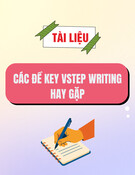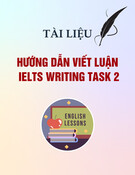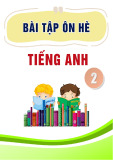
TNU Journal of Science and Technology 230(04): 393 - 400
http://jst.tnu.edu.vn 393 Email: jst@tnu.edu.vn
THE INTERPLAY BETWEEN VIETNAMESE EFL STUDENTS’ ARTIFICIAL
INTELLIGENCE LITERACY AND TOOL USAGE FOR ACADEMIC WRITING
Hoang Viet Hien
*
Ho Chi Minh City University of Economics and Finance
ARTICLE INFO ABSTRACT
Received:
05/03/2025
Artificial intelligence has rapidly been integrated into education, which
has substantially impacted academic writing, especially among EFL
students. This study investigates Vietnamese EFL students’
artificial
intelligence literacy and tool usage
for writing, and the correlation
between these two aspects. A quantitative study using a questionnaire
was conducted with 214 English major students at a private university.
The results reveal that students had a moderate level of a
rtificial
intelligence l
iteracy, with higher competence in awareness and usage
but weaker skills in critical evaluation and ethical considerations.
Similarly, artificial intelligence
tool usage in writing was found to be
moderate. Notably, students mainly employed the tools for g
rammar and
spelling correction, paraphrasing, and time-
saving functions. Moreover,
the study identified a moderate but significant positive correlation
between artificial intelligence
literacy and tool usage. The findings
underscore the need for enhancing students’ a
rtificial intelligence
literacy level, especially critical evaluation, and ethical awareness to
promote students’ engagement with artificial intelligence-
assisted
writing tools.
Revised:
26/04/2025
Published:
29/04/2025
KEYWORDS
Artificial intelligence literacy
Artificial intelligence tool
usage
Artificial intelligence -assisted
writing
Academic writing
Vietnamese EFL students
MỐI TƯƠNG QUAN GIỮA MỨC ĐỘ HIỂU BIẾT VÀ VIỆC SỬ DỤNG CÁC
CÔNG CỤ TRÍ TUỆ NHÂN TẠO TRONG VIẾT HỌC THUẬT CỦA SINH VIÊN
VIỆT NAM HỌC TIẾNG ANH NHƯ MỘT NGOẠI NGỮ
Hoàng Viết Hiền
Trường Đại học Kinh tế - Tài chính Thành phố Hồ Chí Minh
THÔNG TIN BÀI BÁO TÓM TẮT
Ngày nhậ
n bài:
05/03/2025
Trí tuệ nhân tạo đã được tích hợp nhanh chóng vào giáo dục, tạo ra
tác
động đáng kể đến việc viết học thuật, đặc biệt đối với sinh viên học tiế
ng
Anh như một ngoại ngữ. Nghiên cứu này khám phá mức độ hiểu biết và
mức độ sử dụng các công cụ trí tuệ nhân tạo của sinh viên Việ
t Nam
trong viết học thuật, và mối tương quan giữa hai yếu tố này. Mộ
t nghiên
cứu định lượng đã được thực hiện thông qua khảo sát vớ
i 214 sinh viên
chuyên ngành tiếng Anh tại một trường đại học tư thục. Kết quả
cho
thấy sinh viên có mức độ hiểu biết trí tuệ nhân tạo ở mức trung bình, vớ
i
khả năng nhận thức và sử dụng trí tuệ nhân tạo cao hơn, trong khi kỹ
năng đánh giá phản biện và nhận thức đạo đức về trí tuệ nhân tạo
còn
hạn chế. Tương tự, việc sử dụng công cụ trí tuệ nhân tạo trong viết họ
c
thuật cũng ở mức trung bình, chủ yếu để kiểm tra ngữ pháp, chính tả
,
diễn đạt lại câu và tiết kiệm thời gian. Hơn nữa, nghiên cứu đã xác đị
nh
một mối tương quan dương mức trung bình nhưng có ý nghĩa thố
ng kê
giữa mức độ hiểu biết và việc sử dụng các công cụ trí tuệ nhân tạo
trong
viết học thuật. Những phát hiện này nhấn mạnh sự cần thiết phả
i nâng
cao hiểu biết về trí tuệ nhân tạo của sinh viên, đặc biệt là khả
năng đánh
giá phản biện và nhận thức đạo đức, nhằm thúc đẩy việc sử dụng hiệ
u
qu
ả
các công c
ụ
trí tu
ệ
nhân t
ạ
o
h
ỗ
tr
ợ
vi
ế
t
.
Ngày hoàn thiệ
n:
26/04/2025
Ngày đăng:
29/04/2025
TỪ KHÓA
Hiểu biết trí tuệ nhân tạo
Sử dụng công cụ trí tuệ nhân tạo
Trí tuệ nhân tạo hỗ trợ viết
Viết học thuật
Sinh viên Việt Nam học tiếng Anh
như một ngoại ngữ
DOI: https://doi.org/10.34238/tnu-jst.12221
* Corresponding author. Email: hienhv@uef.edu.vn

TNU Journal of Science and Technology 230(04): 393 - 400
http://jst.tnu.edu.vn 394 Email: jst@tnu.edu.vn
1. Introduction
The advancement of artificial intelligence (AI), especially generative AI (GenAI), has had a
significant impact on education in general and in academic writing in particular. AI tools such as
ChatGPT provide immediate feedback, which is essential for language learners [1]. This can help to
enhance grammar, vocabulary, and general writing structure [2]. Similarly, as noted in [3], AI tools
can produce ideas for new topics, detect instances of plagiarism, recognize linguistic mistakes,
provide various expressions or vocabulary options, offer instant and personalized feedback,
translate, summarize works, and use gamification to increase motivation and engagement. Utilizing
AI technologies in the writing process also has the benefit of being widely accessible, allowing
students to practice at their own leisure and pace [4]. All things considered, AI tools provide EFL
students with a great advantage, enhancing their writing skills through personalized feedback,
increased linguistic accuracy, accessibility, and motivation. Previous studies reveal how EFL
students use AI tools to support their writing skills. A survey was conducted to investigate Omani
EFL students’ practices in using AI for writing [5]. The results found that students frequently
employed them to translate words, phrases, and sentences, as well as to check grammar and
spelling. The study [6] investigated Thai and Vietnamese EFL learners’ experiences in using
ChatGPT for second language (L2) writing. They disclosed that students mostly utilized ChatGPT
for brainstorming, organizing ideas, improving outlines, clarifying concepts, and editing their
manuscripts for relevance and accuracy. It was found in [7] that Vietnamese students use ChatGPT
to improve their English argumentative essay writing skills to a moderate extent.
However, the effectiveness and ethical usage of these AI tools is contingent on students’ AI
literacy level [8]. AI literacy refers to essential skills required to comprehend core knowledge and
concepts regarding AI [9], [10]. It entails the efficient use of AI as a tool in online, domestic, and
professional contexts and is a set of competences that enable people to evaluate, and interact with
AI [11]. AI literacy is simply the capacity to recognize, comprehend, generate concepts, and
critically assess AI technologies, their applications, and ethical implications [12]. The study [13]
underscores four critical aspects of AI literacy: awareness, usage, evaluation, and ethics. AI
awareness refers to a person’s evaluation of the AI’s present decision, comprehension of that
decision, and prediction of future decisions. It is evident that using AI requires not only technical
skills, but also an awareness of its ramifications, potential, and limitations. AI usage refers to the
use and application of AI technology to efficiently fulfill activities [13]. With regards to AI
evaluation, it is necessary for people to acquire critical thinking skills in order to avoid copying
and pasting what they have learned from AI. People should be cautious of potential bias,
misinformation, or misleads. Finally, AI ethics addresses issues such as securing student
information, ensuring equal access to AI tools, and minimizing potential exploitation or
overreliance on them. Furthermore, students should be morally conscious of the benefits and
drawbacks of AI use and accept responsibility for their decisions in order to use AI ethically.
Several studies [8], [12], and [14] have been conducted to explore EFL students’ AI literacy
level. All findings uncovered that students possessed moderate AI literacy level. In addition,
students showed greater proficiency in using and understanding their abilities but weaker skills in
critical evaluation and ethical considerations.
In general, despite the benefits of AI tools in academic writing and the importance of AI
literacy in using them effectively, there is a scarcity of research specifically investigating the AI
literacy level of Vietnamese EFL students and the extent to which they use AI tools to support
their academic writing. This study, therefore, first aimed to fill this gap by exploring AI literacy
level and AI tool usage of English major students at a private university in Ho Chi Minh city,
Vietnam. In addition, this study purported to figure out the correlation between students’ AI
literacy and uses of AI tools in writing. In order to achieve these purposes, this study sought to
answer the following questions:

TNU Journal of Science and Technology 230(04): 393 - 400
http://jst.tnu.edu.vn 395 Email: jst@tnu.edu.vn
1. What is the level of AI literacy among Vietnamese EFL students?
2. To what extent do Vietnamese EFL students use AI tools for their academic writing?
3. Is there a correlation between AI literacy level and AI tool usage for academic writing
among Vietnamese EFL students? If there is, how is that correlation?
2. Methodology
2.1. Participants and settings
This study employed quantitative approach to collect and analyze data. It was conducted at the
faculty of English, Ho Chi Minh City University of Economics and Finance where students are
required to complete three writing courses in the curriculum. In addition, they need to accomplish
writing assignments in other courses such as Research Methodology, Cross-cultural
Communication and so on.
As a result of convenience sampling method, 214 English major students agreed to complete
the questionnaires. Before that, they were given a consent form with a thorough explanation
regarding the research. Overall, there were 78% females (n = 167) and 22% males (n = 47). Out
of the 214 participants, third-year students constituted the largest group, with 87 responses
(40.7%). This was followed by second-year students, who accounted for 48 responses (22.4%),
and first-year students, contributing 41 responses (19.2%). The smallest group was fourth-year
students, with 38 responses (17.7%). All students reported that they had used AI tools such as
ChatGPT, Grammarly, Quillbot, to support their academic writing.
2.2. Research instruments
In order to investigate students’ AI literacy level and uses of AI tools for academic writing,
this study utilized a close-ended questionnaire to collect data. In terms of AI literacy level, the AI
literacy scale (AILS) from [13] was adopted. It encompassed 4 subscales (awareness, usage,
evaluation, and ethics) with 12 5-point Likert items (1- Strongly disagree, 2- Disagree, 3-
Neutral, 4- Agree, 5- Strongly agree). Meanwhile, the AI tool usage section was adopted from [5]
with 11 5-point Likert items (1- Never, 2- Rarely, 3- Sometimes, 4- Usually, 5- Always). In
addition, students’ personal information was identified through the questions related to their
gender, academic year, and their familiarity with AI tools. The questionnaire was translated into
Vietnamese and was validated by three experts in ELT. It was also piloted with 5 students to
facilitate student responses and avoid misconceptions, resulting in more accurate data. In
addition, Cronbach’s alpha was employed to assess the reliability with a result of 0.85, indicating
strong internal consistency.
2.3. Data collection and analysis
The questionnaire for the study was administered online utilizing Google Forms, and
participants were given a link to access it. The participants provided their consent forms, which
were attached to the questionnaire, to confirm their participation in the study. The questionnaire
links remained accessible for a period of two weeks. After the data were collected, SPSS (version
25) was utilized to analyze them. Descriptive and inferential statistics were applied to identify
students’ AI literacy level and uses of AI tools for academic writing as well as the correlation
between these variables.
3. Results and Discussion
3.1. Vietnamese EFL students’ AI literacy level
For the first research question regarding Vietnamese EFL students’ AI literacy level, Table 1
shows that students had a moderate level of AI literacy (M = 3.03, SD = 0.93). To be more
specific, students scored the highest in usage (M = 3.12, SD = 0.89) and awareness (M = 3.10,

TNU Journal of Science and Technology 230(04): 393 - 400
http://jst.tnu.edu.vn 396 Email: jst@tnu.edu.vn
SD = 0.92), suggesting their familiarity and confidence in using AI tools. However, evaluation
(M = 2.98, SD = 0.85) and ethics (M = 2.92, SD = 0.90) witnessed comparatively lower scores.
This indicates students’ weaker critical and ethical engagement with AI tools.
Table 1. Descriptive statistics of AI literacy
Subscales
Mean
Standard Deviation
Interpretation
Awareness
3.
10
0.92
Moderate
Usage
3.
12
0.89
Moderate
Evaluation
2.98
0.85
Moderate
Ethics
2.92
0.90
Moderate
Overall AI Literacy
3.03 0.93 Moderate
Table 2 illustrates detailed analysis of AI literacy subscales. In terms of students’ awareness,
students demonstrated a good ability to identify AI-integrated applications (M = 3.15, SD =
0.88). This suggests that students were basically familiar with commonly used AI tools.
However, the lower score on how AI can assist them (M = 3.00, SD = 1.01) indicates that some
students still struggle to understand the practical benefits of AI in academic settings.
Table 2. Detailed analysis of AI literacy subscales
Statements Constructs Mean Standard Deviation
Interpretation
1 I can distinguish between smart devices and non
-
smart devices.
Awareness 3.08 0.92 Moderate
2 I do not know how AI technology can help me.
(
Reversed
)
Awareness 3.00 1.01 Moderate
3 I
can identify the AI technology employed in the
applications and products I use.
Awareness 3.15 0.88 Moderate
4 I can skill
fully use AI applications or products to
help me with my daily work.
Usage 3.12 0.89 Moderate
5 It is usually hard for me to
learn to use a new AI
application or product.
(
Reversed
)
Usage 2.98 0.95 Moderate
6
I can use AI applications or products to improve
my work efficiency.
Usage 3.14 0.91 Moderate
7
I can evaluate the capabilities and limitations of an
AI
application or product after using it for a while.
Evaluation 2.98 0.85 Moderate
8
I can choose a proper solution from various
solutions provided by a smart agent.
Evaluation 2.96 0.93 Moderate
9 I can choose the most appropriate AI
application
or product from a variety for a particular task.
Evaluation 2.97 0.87 Moderate
10
I always comply with ethical principles when
using AI applications or products.
Ethics 2.94 0.82 Moderate
11
I am never alert to privacy and information
security issues when using AI applications or
products.
(
Reversed
)
Ethics 2.90 1.05 Moderate
12 I am always alert to the abuse of AI technology. Ethics 2.92 0.90 Moderate
With regards to usage of AI, the highest score was for improving work efficiency (M = 3.14,
SD = 0.91). Meanwhile, many students reported difficulty in learning new AI technologies (M =
2.98, SD = 0.95). For the evaluation, while students fairly felt confident in selecting AI tools for
specific tasks (M = 2.97, SD = 0.87), their ability to evaluate AI-generated solutions (M = 2.96,
SD = 0.93) was lower. Last but not least, regarding ethics, even though students could
moderately recognize the importance of using AI responsibly (M = 2.94, SD = 0.82), they
appeared less concerned about privacy and security risks (M = 2.90, SD = 1.05).
These results align well with previous studies [8], [12], and [14] in which students possess
moderate level of AI literacy and tend to improve operational skills before acquiring deeper
critical and ethical awareness. This could be attributed to the focus of AI exposure in students’
learning environments. That is to say, many AI tools are designed for ease of use, offering
automated suggestions for grammar correction, paraphrasing, and text generation, which require

TNU Journal of Science and Technology 230(04): 393 - 400
http://jst.tnu.edu.vn 397 Email: jst@tnu.edu.vn
minimal user intervention [15]. As a consequence, students may become proficient in technically
using AI tools but remain passive users who do not critically question AI-generated content. In
other words, students have a tendency to over-rely on AI-generated responses without verifying
their accuracy or considering alternative sources of information [16], [17]. Moreover, ethical
considerations in AI usage represent another key area of weakness among students. The results
indicate that there is a lack of students’ awareness in relation to ethical issues including privacy
issues, data security, and academic dishonesty. This evidence corroborates earlier findings, which
claims that students often use AI tools without fully understanding the ethical implications of AI in
education [12], [18]. One possible cause for this problem might be because there are not enough
explicit institutional guidelines on AI usage which can help students use AI tools more ethically. In
short, although students have demonstrated abilities in operating AI tools, they need further
instruction in evaluating content from AI and recognizing the ethical consequences of AI use [19].
3.2. Vietnamese EFL students’ uses of AI tools in academic writing
Regarding students’ AI tool usage, as can bee seen in Table 3, the overall findings reveal that
students showed a moderate level of AI tool usage (M = 3.15, SD = 0.82).
The most common utilization of AI tools belonged to checking grammar and spelling, saving time,
paraphrasing and generating ideas. To be more specific, grammar checking was the most commonly
used feature (M = 3.20, SD = 0.79), followed closely by spelling checks (M = 3.18, SD = 0.81).
Table 3. Descriptive statistics of AI tool usage for writing
Statements
Mean
Standard
Deviation
Interpretation
1
I use AI writing tools to write my exercises and
assignments.
3.05 0.88 Moderate
2
I use AI
writing tools to refine and paraphrase texts.
3.08
0.85
Moderate
3
I use AI writing tools to translate words, phrases, and
sentences.
3.02 0.90 Moderate
4
I use AI writing tools to check the spelling of words.
3.18
0.81
Moderate
5
I use AI
writing tools to check for grammatical errors.
3.
20
0.79
Moderate
6
I use AI writing tools to edit my style of writing.
2.97
0.87
Moderate
7
I use AI writing tools to write paragraphs and essays.
2.95
0.92
Moderate
8 I use AI writing tools to
create a full list of the
sources/references used.
2.88 0.95 Moderate
9
I use AI writing tools to summarize texts/paragraphs to be
used in my writing.
2.90 0.97 Moderate
10
I use AI writing tools to save time when writing.
3.
12
0.84
Moderate
11
I use
AI writing tools to generate ideas to be used in writing.
3.
06
0.89
Moderate
Overall
AI tool usage
3.15
0.82
Moderate
Also, students reported using AI tools to save time during the writing process (M = 3.12, SD =
0.84). What is more, many students used AI tools to refine and paraphrase texts (M = 3.08, SD =
0.85) and to generate new ideas for their writing (M = 3.06, SD = 0.89). On the other hand, the
less frequent uses of AI tools lied in source or reference management and summarization.
Specifically, the least frequently used feature was creating a list of sources/references (M = 2.88,
SD = 0.95). In addition, AI tools for summarizing texts/paragraphs were also among the less
commonly employed features (M = 2.90, SD = 0.97).
The findings are congruent with existing literature [5]-[7] which disclose that students
moderately use AI tools and perceive AI as a proofreading and revision tool rather than a crucial
part of the academic writing process. Literally, there have been plenty of AI-assisted writing tools
such as Grammarly, QuillBot, and ChatGPT that are developed to assist students in correcting
grammar, paraphrasing, and suggesting clarity. This makes them easily accessible and applicable
to students’ immediate writing needs [20], [21]. These AI tools provide fast and convenient
solutions to linguistic challenges, reducing the cognitive load associated with proofreading and
editing. However, their limited adoption for more complex writing functions such as referencing




![Mẫu thư Tiếng Anh: Tài liệu [Mô tả chi tiết hơn về loại tài liệu hoặc mục đích sử dụng]](https://cdn.tailieu.vn/images/document/thumbnail/2025/20250814/vinhsannguyenphuc@gmail.com/135x160/71321755225259.jpg)


![Mẫu câu viết thư thân mật bằng Tiếng Anh [Chuẩn Nhất]](https://cdn.tailieu.vn/images/document/thumbnail/2025/20250708/caotiendat91211.thd2017@gmail.com/135x160/80151751961845.jpg)
![Tài liệu gợi ý viết email tiếng Anh và 35 đề thi mẫu [chuẩn SEO]](https://cdn.tailieu.vn/images/document/thumbnail/2025/20250708/caotiendat91211.thd2017@gmail.com/135x160/25321751961846.jpg)



![Tài liệu Từ vựng tiếng Anh Trung cấp [mới nhất]](https://cdn.tailieu.vn/images/document/thumbnail/2025/20250913/nguyentuan250421@gmail.com/135x160/99491757910839.jpg)
![Tài liệu Từ vựng Tiếng Anh theo chủ đề [mới nhất]](https://cdn.tailieu.vn/images/document/thumbnail/2025/20250913/namdhuet@gmail.com/135x160/83251757753810.jpg)



![Tài liệu Từ vựng tiếng Anh cho bé [chuẩn nhất/mới nhất]](https://cdn.tailieu.vn/images/document/thumbnail/2025/20250731/huadaithesang2509@gmail.com/135x160/18631754013896.jpg)








